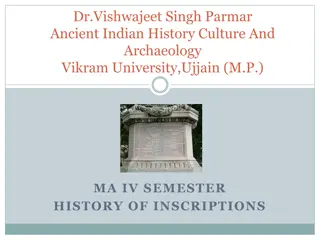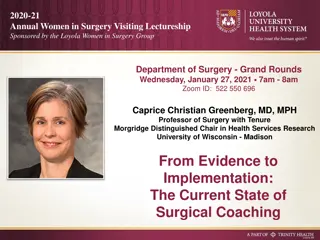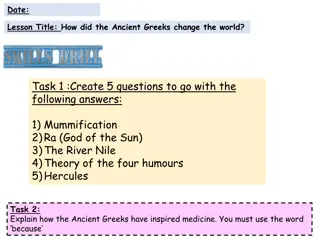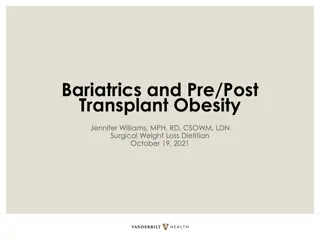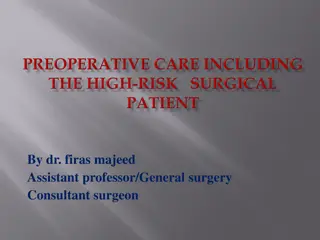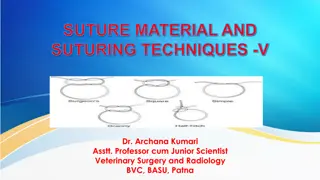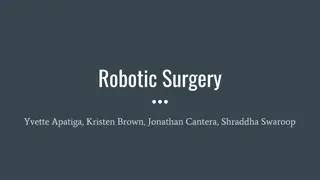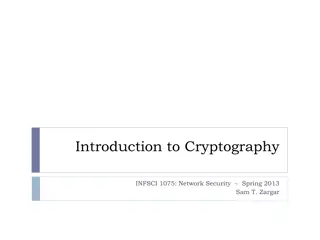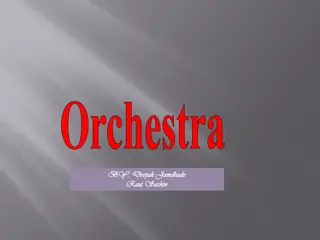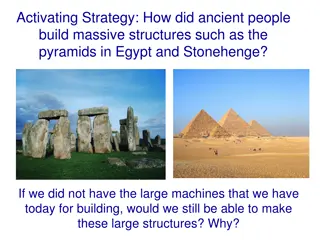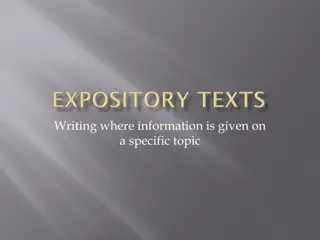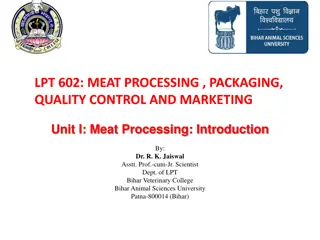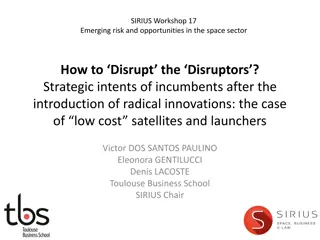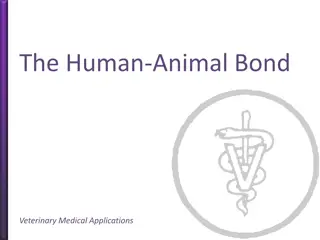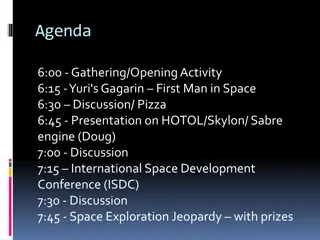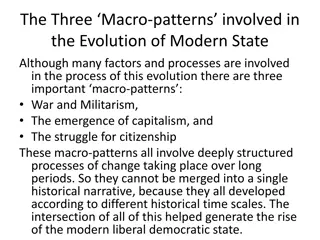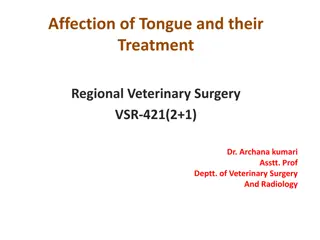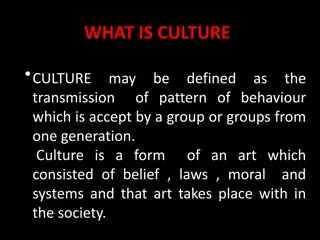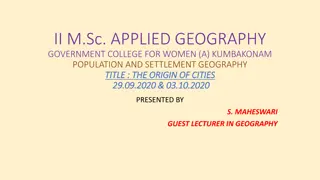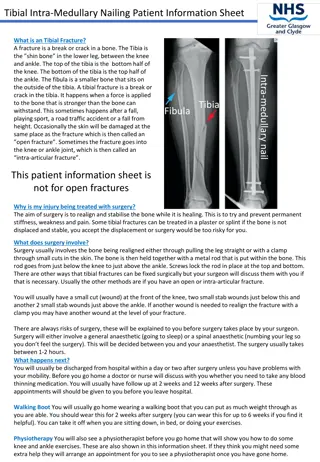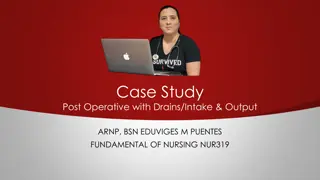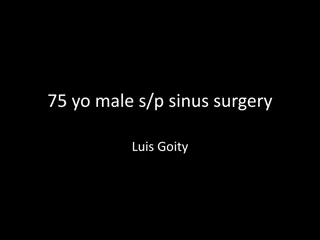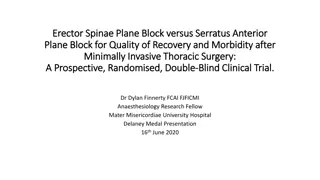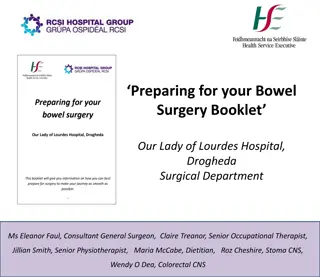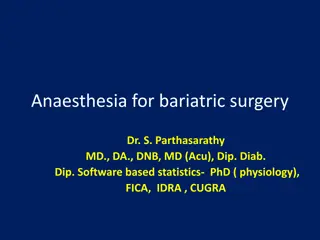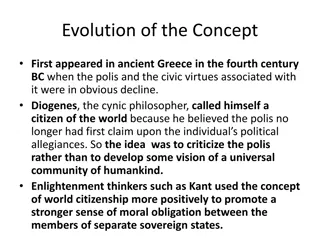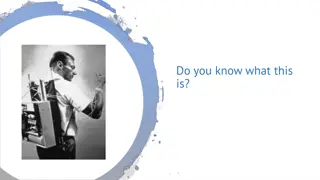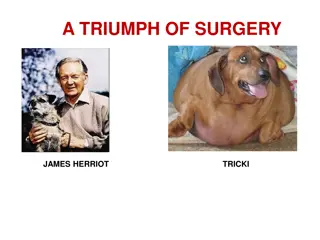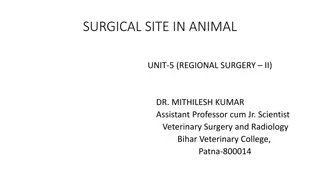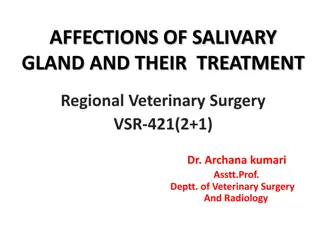Evolution of Veterinary Surgery: Insights from Ancient India to Modern Innovations
Delve into the historical perspective and advancements in veterinary surgery, starting with ancient Indian veterinarians like Salihotra and Palakapya, through the foundational work of Susruta Samhita, to the modern developments in surgical methods like anesthesia, microbiology, antibiotics, and blood transfusion. Explore the rich legacy of veterinary science and the evolution that has paved the way for modern surgical practices.
Uploaded on Jul 25, 2024 | 0 Views
Download Presentation

Please find below an Image/Link to download the presentation.
The content on the website is provided AS IS for your information and personal use only. It may not be sold, licensed, or shared on other websites without obtaining consent from the author. Download presentation by click this link. If you encounter any issues during the download, it is possible that the publisher has removed the file from their server.
E N D
Presentation Transcript
General Surgery-I Dr. Archana Kumari Asstt. Professor cum Junior Scientist Veterinary Surgery and Radiology BVC, BASU, Patna .
Historical perspective Salihotra and palakapya were the greatest of ancient India veterinarians Salihotra treated horses & Palapya treated Elephants According to Vedas, medical science arose from veterinary science. The earliest work on medicine is known as Atharvaveda which existed in 1,000 B.C. Salihotra
Cont. Susruta Samhita is the earliest known work dealing with medical science (especially surgery ) Susruta Samhita contains details of discourses by the holy sage Dhanvantri to his disciples Susruta and his colleagues Surgery was given a place of honour in Susruta Samhita . Susruta Samhita is written in Sanskrit and divided into 120 chapters, distributed in 5 divisions.
Cont. A large part of Susruta Samhita is devoted to surgery and it includes :- Preliminary preparations for surgery, Various types of instruments and their care Teaching of surgical methods Dressing and bandaging of wounds Symptoms to predict prognosis of the surgical case
Special Surgical methods include Special Surgical methods include Application of cautery, Removal of foreign bodies and obstructions, Surgical grafting (specially of ears lobes), Dislocations, Piles and fistula. Methods of suturing and nurse have been dealt with in detail. A special emphasis on the dissection of a dead body of the human body is given
Cont. The first highly organized department of livestock in indian history has been given by kautalya in his Arthashastra under king Chandragupt maurya (322-298 B.C.) The Great Emperor Ashoka developed organized veterinary hospitals throughout his kingdom (273-232 B.C.) Most ancient texts on medical & veterinary sciences were lost or destroyed in the war One of the reasons for non availability of ancient knowledge was the known secretive nature of the Indian scholars.
Cont. Oral discourse were the common ways of knowledge propagation In the 16th century, veterinary schools were established in spain to grant licences for veterinary practice but schools did not last long Major achievements which made modern surgery possible include The development of anaesthesia, Microbiology, Discovery of antibiotics and Methods of blood transfusion. These achievement were made in about 100 years beginning from 1846.
Cont. The first public demonstration of Ether anaesthsia was made in 1846 by W.T.G. Morten C.P. Jackson, a Boston physician, appears to be the first to apply ether anaesthesia extensively in animals in 1853 Joseph Lister introduced the theory and practice of asepsis. In 1875, One reported intravenous anaesthesia using chloral hydrate and three years later Humbert used in a horse. Pean in 1867 popularized a forceps for controlling haemorrhage. W. S. Halsted in 1894 propagated maintaining a dry operative field and introduced the use of rubber gloves.
Cont. Sterilisation by boiling was introduced by Von Bergmann in 1886. Discovery of X-rays was done by Roentgen in 1895 In 1898, August Bier of Germany produced true spinal anaesthesia in animals In 1901,Cuille and Sendrail of Franc induced subarachnoid anaesthesia in horse, cattle and dogs. R Eberlein of Germay, is considered as the father of veterinary radiology, elaborated the use of X-rays in veterinary practice during the period of 1897-1916.
Cont. The concept of splints to correct over-riding fracture in dogs was adopted by Schroeder in 1933 Paralumabar anaesthesia was introduced in medical science by selheim in 1909, the technique was applied to cattle by Farquharson and Formston in 1940. The Indian Society for Veterinary Surgery was formed in 1977 at Hisar.
INTRODUCTION INTRODUCTION Surgery is an art and practice of treating injuries, deformities and other disorders by manual operations or instrumental appliances In Latin, surgery is referred to as chirurgia Greek synonym is cheirourgia and the word cheir means hand and ergon to work
CLASSIFICATION OF SURGERY Surgery can be classified according to: Nature of surgery, Region/system involved, and Instruments/appliances used.
Nature Of Surgery General surgery : carried out to restore the normal function of the body or a part without substituting or discarding any part of the body .It is also called Restorative surgery e.g. Rumenotomy Extirpative surgery : involves the removal of a part e.g. Hysterectomy. Plastic surgery : to restore disturbed function and includes reconstructive and cosmetic surgery
Cont. Replacement surgery means replacement of a diseases part by either a living tissue (vascular graft), non-living material (heart valve)or dead tissue tissue (corneal or bone graft). Physiological surgery involves alterations in the normal physiological mechanisms for the benefit of the whole body e.g. vascular shunts. Surgery done to arrive at a diagnosis is called Diagnostic surgery (exploratory laparotomy, biopsy, paracentesis). Experimental surgery is done solely for the purpose of experiments e.g. making carotid loops.
Region/ System involved : Specialize on a particular region or system e.g. Thoracic surgery Cardiovascular surgery, Orthpaedic surgery, Ophthalmic surgery neurosurgery, Urogenital surgery.
Instruments/Appliances used: In Microsurgery, magnification facilities are used for specialized surgical procedures. Cryosurgery involves controlled use of substances like liquid nitrogen which produces freezing temperatures to destroy abnormal tissues. In Electrosurgery, electricity is converted to heat to incise a tissue. In laser surgery laser beams are used to cut or destroy the diseased tissue. Surgery in which high frequency waves are used to destroy a particular tissue or a substance is called as Ultrasonic surgery e.g. lithotripsy. Microsurgery Electrosurgery
Reasons for Surgery To save the life of an animal To prolong the life of an animal To hasten recovery from an injury (wound suturing) For elimination of disease process (extraction of tumour) For cosmetic reasons (ear cropping) For correcting deformities or malformations To aid in diagnosis of a suspected pathological process (exploratory laparotomy) For investigation in research work (Experimental surgery)
. TENETS OF HALSTEAD GENTLE HANDLING OF TISSUE METICULOUS HAEMOSTASIS PRESERVATION OF BLOOD SUPPLY STRICT ASEPTIC TECHNIQUE MINIMUM TENSION ON TISSUES ACCURATE TISSUE APPOSITION OBLITERATION OF DEADSPACE


